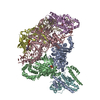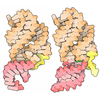+ Open data
Open data
- Basic information
Basic information
| Entry | Database: PDB / ID: 9n6c | |||||||||
|---|---|---|---|---|---|---|---|---|---|---|
| Title | Structure of the Retron IA Complex without the HNH Nuclease | |||||||||
 Components Components |
| |||||||||
 Keywords Keywords | Transferase/DNA/RNA / Retron / IA / Immune / Transferase-DNA-RNA complex | |||||||||
| Function / homology |  Function and homology information Function and homology informationDNA synthesis involved in DNA repair / RNA-directed DNA polymerase / RNA-directed DNA polymerase activity / double-strand break repair / defense response to virus / RNA binding Similarity search - Function | |||||||||
| Biological species |  | |||||||||
| Method | ELECTRON MICROSCOPY / single particle reconstruction / cryo EM / Resolution: 2.99 Å | |||||||||
 Authors Authors | Burman, N. / Thomas-George, J. / Wilkinson, R. / Wiedenheft, B. | |||||||||
| Funding support |  United States, 2items United States, 2items
| |||||||||
 Citation Citation |  Journal: bioRxiv / Year: 2025 Journal: bioRxiv / Year: 2025Title: Structural basis of antiphage defense by an ATPase-associated reverse transcriptase. Authors: Jerrin Thomas George / Nathaniel Burman / Royce A Wilkinson / Senuri de Silva / Quynh McKelvey-Pham / Murat Buyukyoruk / Adelaide Dale / Hannah Landman / Ava Graham / Steven Z DeLuca / Blake Wiedenheft /  Abstract: Reverse transcriptases (RTs) have well-established roles in the replication and spread of retroviruses and retrotransposons. However, recent evidence suggests that RTs have been conscripted by cells ...Reverse transcriptases (RTs) have well-established roles in the replication and spread of retroviruses and retrotransposons. However, recent evidence suggests that RTs have been conscripted by cells for diverse roles in antiviral defense. Here we determine structures of a type I-A retron, which explain how RNA, DNA, RT, HNH-nuclease and four molecules of an SMC-family ATPase assemble into a 364 kDa complex that provides phage defense. We show that phage-encoded nucleases trigger degradation of the retron-associated DNA, leading to disassembly of the retron and activation of the HNH nuclease. The HNH nuclease cleaves tRNA, stalling protein synthesis and arresting viral replication. Taken together, these data reveal diverse and paradoxical roles for RTs in the perpetuation and elimination of genetic parasites. | |||||||||
| History |
|
- Structure visualization
Structure visualization
| Structure viewer | Molecule:  Molmil Molmil Jmol/JSmol Jmol/JSmol |
|---|
- Downloads & links
Downloads & links
- Download
Download
| PDBx/mmCIF format |  9n6c.cif.gz 9n6c.cif.gz | 412.2 KB | Display |  PDBx/mmCIF format PDBx/mmCIF format |
|---|---|---|---|---|
| PDB format |  pdb9n6c.ent.gz pdb9n6c.ent.gz | 317.9 KB | Display |  PDB format PDB format |
| PDBx/mmJSON format |  9n6c.json.gz 9n6c.json.gz | Tree view |  PDBx/mmJSON format PDBx/mmJSON format | |
| Others |  Other downloads Other downloads |
-Validation report
| Summary document |  9n6c_validation.pdf.gz 9n6c_validation.pdf.gz | 1.6 MB | Display |  wwPDB validaton report wwPDB validaton report |
|---|---|---|---|---|
| Full document |  9n6c_full_validation.pdf.gz 9n6c_full_validation.pdf.gz | 1.6 MB | Display | |
| Data in XML |  9n6c_validation.xml.gz 9n6c_validation.xml.gz | 69 KB | Display | |
| Data in CIF |  9n6c_validation.cif.gz 9n6c_validation.cif.gz | 108.9 KB | Display | |
| Arichive directory |  https://data.pdbj.org/pub/pdb/validation_reports/n6/9n6c https://data.pdbj.org/pub/pdb/validation_reports/n6/9n6c ftp://data.pdbj.org/pub/pdb/validation_reports/n6/9n6c ftp://data.pdbj.org/pub/pdb/validation_reports/n6/9n6c | HTTPS FTP |
-Related structure data
| Related structure data |  49056MC  9n69C  9n6bC M: map data used to model this data C: citing same article ( |
|---|---|
| Similar structure data | Similarity search - Function & homology  F&H Search F&H Search |
- Links
Links
- Assembly
Assembly
| Deposited unit | 
|
|---|---|
| 1 |
|
- Components
Components
| #1: Protein | Mass: 63393.953 Da / Num. of mol.: 4 / Mutation: N-terminal MWSHPQFEK, del native fMet Source method: isolated from a genetically manipulated source Source: (gene. exp.)   #2: Protein | | Mass: 36046.191 Da / Num. of mol.: 1 Source method: isolated from a genetically manipulated source Source: (gene. exp.)   References: UniProt: A0AAD2V6H6, RNA-directed DNA polymerase #3: DNA chain | | Mass: 49825.891 Da / Num. of mol.: 1 Source method: isolated from a genetically manipulated source Source: (gene. exp.)   #4: RNA chain | | Mass: 52084.648 Da / Num. of mol.: 1 Source method: isolated from a genetically manipulated source Source: (gene. exp.)   #5: Chemical | Has ligand of interest | Y | Has protein modification | N | |
|---|
-Experimental details
-Experiment
| Experiment | Method: ELECTRON MICROSCOPY |
|---|---|
| EM experiment | Aggregation state: PARTICLE / 3D reconstruction method: single particle reconstruction |
- Sample preparation
Sample preparation
| Component | Name: Retron IA surveillance complex with HNH nuclease bound in the "down" orientation Type: COMPLEX / Entity ID: #1-#4 / Source: RECOMBINANT |
|---|---|
| Molecular weight | Experimental value: NO |
| Source (natural) | Organism:  |
| Source (recombinant) | Organism:  |
| Buffer solution | pH: 7.5 |
| Specimen | Embedding applied: NO / Shadowing applied: NO / Staining applied: NO / Vitrification applied: YES |
| Specimen support | Grid material: COPPER / Grid mesh size: 300 divisions/in. / Grid type: C-flat-1.2/1.3 |
| Vitrification | Instrument: FEI VITROBOT MARK IV / Cryogen name: ETHANE / Humidity: 100 % / Chamber temperature: 277.15 K |
- Electron microscopy imaging
Electron microscopy imaging
| Experimental equipment |  Model: Talos Arctica / Image courtesy: FEI Company |
|---|---|
| Microscopy | Model: FEI TALOS ARCTICA |
| Electron gun | Electron source:  FIELD EMISSION GUN / Accelerating voltage: 200 kV / Illumination mode: FLOOD BEAM FIELD EMISSION GUN / Accelerating voltage: 200 kV / Illumination mode: FLOOD BEAM |
| Electron lens | Mode: BRIGHT FIELD / Nominal magnification: 45000 X / Nominal defocus max: 2500 nm / Nominal defocus min: 800 nm / Cs: 2.7 mm / C2 aperture diameter: 50 µm / Alignment procedure: COMA FREE |
| Specimen holder | Cryogen: NITROGEN / Specimen holder model: FEI TITAN KRIOS AUTOGRID HOLDER |
| Image recording | Electron dose: 56.69 e/Å2 / Film or detector model: GATAN K3 (6k x 4k) / Num. of grids imaged: 1 / Num. of real images: 13695 |
- Processing
Processing
| EM software |
| |||||||||||||||||||||||||||||||||||||||||||||||||||||||
|---|---|---|---|---|---|---|---|---|---|---|---|---|---|---|---|---|---|---|---|---|---|---|---|---|---|---|---|---|---|---|---|---|---|---|---|---|---|---|---|---|---|---|---|---|---|---|---|---|---|---|---|---|---|---|---|---|
| CTF correction | Type: PHASE FLIPPING AND AMPLITUDE CORRECTION | |||||||||||||||||||||||||||||||||||||||||||||||||||||||
| Particle selection | Num. of particles selected: 5915380 Details: Particles picked using a 20 Angstrom lowpass filtered template volume that was produced de novo using blob picked particles | |||||||||||||||||||||||||||||||||||||||||||||||||||||||
| Symmetry | Point symmetry: C1 (asymmetric) | |||||||||||||||||||||||||||||||||||||||||||||||||||||||
| 3D reconstruction | Resolution: 2.99 Å / Resolution method: FSC 0.143 CUT-OFF / Num. of particles: 513948 / Algorithm: FOURIER SPACE Details: Reported resolution from cryoSPARC's GSFSC estimation Num. of class averages: 1 / Symmetry type: POINT | |||||||||||||||||||||||||||||||||||||||||||||||||||||||
| Atomic model building | Protocol: RIGID BODY FIT / Space: REAL / Target criteria: Cross-correlation coefficient Details: Alphafold predicted structures of each individual subunit were first rigid body fit in ChimeraX using the fit in map command before initial relaxation using ISOLDE and final refinement in ...Details: Alphafold predicted structures of each individual subunit were first rigid body fit in ChimeraX using the fit in map command before initial relaxation using ISOLDE and final refinement in PHENIX RealSpaceRefinement. COOT was used for manual editing. | |||||||||||||||||||||||||||||||||||||||||||||||||||||||
| Atomic model building | Details: The structure of each subunit was predicted individually in Alphafold before rigid body fitting in ChimeraX Source name: AlphaFold / Type: in silico model |
 Movie
Movie Controller
Controller





 PDBj
PDBj

































































